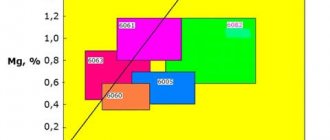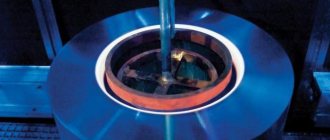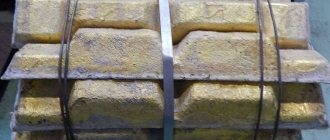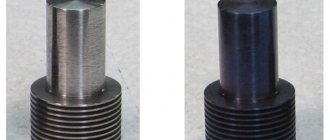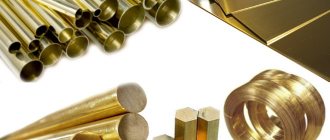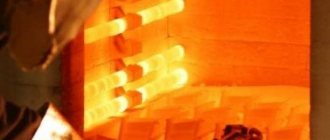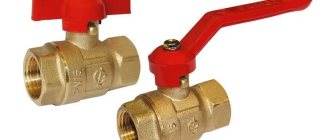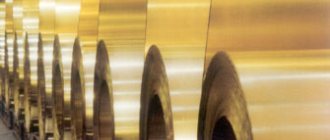Strength, dimensional control and performance are the three main factors taken into account when deciding to produce a competitive aluminum extrusion.
Aluminum alloys are grouped into two categories - thermally non-hardening and thermally hardening. Thermally non-hardening alloys include alloys of the 1xxx, 3xxx and 5xxx series, which achieve their full strength upon subsequent deformation at room temperature. Thermally hardenable alloys - alloys of the 2xxx, 4xxx, 6xxx and 7xxx series - obtain their full strength due to:
- hardening of profiles depending on the temperature at the exit from the matrix (T5 condition);
- hardening of profiles from the temperature of a separate furnace heating in special tanks with water (condition T6).
Why alloys 6060, 6063 and AD31?
The main advantages of the 6xxx series aluminum alloys are that they are relatively easy to press and are hardened directly on the press to achieve the maximum strength T6 state. It is clear that the exclusion of the hardening operation with separate heating from the production technology of aluminum profiles is a big saving for production. (See Press hardening for more details). Moreover, most profiles made from the popular 6060 and 6063 aluminum alloys require only air from fans for their hardening, and only the thickest ones require stronger and faster air flows.
Thermal and strain hardening
The properties of an aluminum alloy depend not only on its chemical composition, but also on the history of its thermal and deformation treatments.
Wrought aluminum alloys, the strength of which can be increased by heat treatment, are called heat-hardenable alloys. These alloys include all alloys of the 2xxx, 6xxx and 7xxx series. Sometimes deformation treatment is also applied to these alloys, both before and after heat treatment.
Aluminum alloys of the 1xxx, 3xxx and 5xxx series are not able to increase their strength under the influence of heat treatment. Their strength properties are increased by deformation treatment (hardening).
Most cast aluminum alloys are heat hardenable. Cast aluminum alloys are usually not subjected to cold hardening due to their low ductility.
Chemical description of the alloy
Structural aluminum alloys duralumin
The characteristics of AD31T1 are regulated by GOST 4784-74. This alloy is made on the basis of aluminum, the share of which is about 99.3% of the total mass. The remaining 0.7% is silicon and magnesium. In addition to them, this small mass fraction also includes titanium, iron, zinc and manganese.
For example, the characteristics of AD31T1 vary greatly due to the fact that the amount of iron is approximately 0.5%. Because of this, ductility and strength are reduced, since this component forms various intermetallic compounds. However, at the same time, for example, it reduces the tendency of the material to crack during casting. As for manganese, it has a positive effect on the material’s resistance to corrosion, and also eliminates the loss of strength of the alloy during aging.
If we talk about the full percentage list of chemical elements in this alloy, it looks like this:
- iron - up to 0.5%;
- silicon from 0.2 to 0.6%;
- amount of manganese - up to 0.1%;
- chromium content - up to 0.1%;
- titanium contains a little more - up to 0.15%;
- aluminum occupies from 97.65 to 99.35% of the total mass fraction;
- there is as much copper as manganese;
- magnesium - from 0.45 to 0.9%;
- zinc - up to 0.2%.
In the end, it is worth adding that the characteristics of the AD31T1 alloy in terms of chemical indicators are very close to the composition of the 6060 alloy, which is quite widely used in Western Europe.
The difference is that 6060 contains less iron - from 0.1 to 0.3%. However, it is worth noting that the presence of this component has practically no effect on the mechanical qualities.
Chemical composition
6082 Aluminum Alloy Composition:
Chemical composition of aluminum 6082
| Element | Weight percentage (%) |
| Aluminum | 95,2–98,3 |
| Chromium | 0.25% max. |
| Copper | 0.1% max. |
| Iron | 0.5% max. |
| Magnesium | From 0.6 to 1.2% |
| Mangenese | From 0.4 to 1.0% |
| Silicon | From 0.7 to 1.3% |
| Titanium | 0.1% max. |
| Zinc | 0.2% max. |
| leftovers | 0.15% max. |
Increased ductility
Tsam alloys - composition, properties and scope of application
Alloys of the Al-Mg-Si system are widely used in production due to their complex of valuable properties. Alloys AD31, AD33, AD35, AD and 6000 series have good corrosion resistance, manufacturability, high ductility in the hot state, and alloy AB - in the hot and cold state. These alloys are subjected to color anodizing, enameling, and enamelling. When hot, they are used to produce profiles, blanks and semi-finished products of complex shapes.
Corrosion-resistant Al-Mg-Si alloys are ductile in the annealed, freshly quenched and naturally aged state. Alloys are stamped, drawn and deformed to significant degrees. Compared to the ductile alloys AMg5 and AMg6, alloys AD31, AD33, AD35, AD and 6000 series are weakly cold-worked and hardened during cold deformation, which reduces or eliminates intermediate annealing at high degrees of deformation.
Alloys are strengthened by heat treatment according to the following modes: hardening (heating at t
=515-525°C, cooling in cold water), natural aging at room temperature for about 10 days;
hardening, artificial aging at a temperature of 160-170°C for 10-12 hours. Annealing of semi-finished products is carried out at temperatures of 350-370°C (AD35, AB); 350-400°C (AD31); 380-420°C (AD33). This is followed by cooling in an oven at a rate of 30°/h to t
= 250°C, followed by further cooling in air.
Corners from AD31T1
Alloys
Corners made of AD31T1 have also become very popular. The characteristics of this alloy made it possible to achieve the following advantages.
Firstly, the light weight of the corners made it possible to significantly reduce the weight of the frame during its creation. Secondly, ductility and ease of processing played a significant role, since the shape can be changed with hand tools if necessary, and after welding small and neat seams will remain. In addition, there is a high level of resistance to various aggressive environmental influences, as well as oxidation. This significantly increased the durability of the corners, which is one of the key factors in the construction of the same frame.
Using AD3 aluminum alloy
The AD31 alloy is especially ductile when hot and allows the production of hollow semi-finished products of complex shapes by pressing. At the same time, the surface of the products lends itself perfectly to decorative processing, including powder coating or color anodizing. Thus, a variety of aluminum products are produced, painted in any color: blue, green, yellow, white, red.
AD31 alloy is no less widely used in the manufacture of aluminum profiles (more than 57% of all manufactured products) used in the construction of substructures of curtain facades. They are worthy competitors to similar products made of galvanized steel, since they do not corrode and do not require periodic application of a protective coating to their surface. Due to its high corrosion resistance and non-toxicity, aluminum alloy AD31 is in demand in the manufacture of containers for the transportation and storage of concentrated nitric acid, organic substances, hydrogen peroxide and food. It is used to make foil for cans and tetrapacks, milk flasks, bottle caps and other products. In recent years, AD31 alloy has been used in the production of communication cables and overhead wires because it has higher strength than copper. This allows you to increase the size of the spans and reduce the amount of damage during the installation of power lines. At the same time, in terms of electrical conductivity, aluminum alloy AD31 is in second place after copper, and its cost is 1.5 times cheaper
Plus, aluminum is lighter, which is very important in the production of compact units that include a large number of conductive materials. In our company you can purchase pipes, circles, rods and profiles made from AD31 alloy
Our managers will organize delivery of the material on time, and will also provide all the necessary certificates indicating the high quality of rolled metal.
Aluminum tires AD0 and AD31t. Differences
Aluminum bus or electrical aluminum bus is used to create busbars and power distribution devices in electrical engineering and energy.
In accordance with the requirements of GOST 15176-89, rectangular aluminum tires of grades A6, A5, AD0, AD31 and AD31t are produced.
The most widely used are pressed aluminum tires of the following brands: AD0 or AD31t (naturally aged hardened).
The chemical composition of aluminum tires AD0, AD31t corresponds to GOST 4784. The main difference is the quality of the material. The aluminum bus AD0 differs from the AD31t bus in the purity of the metal 99.5%, the absence of magnesium and silicon in the alloy composition.
The choice of aluminum alloy brand depends on the purpose of the aluminum tire. An aluminum tire made from technical aluminum AD0 is the most ductile, since this material contains a minimum amount of impurities in its composition.
Aluminum tires of the AD31t brand have a composition that includes alloying components, thanks to which the aluminum tire becomes better in elasticity and strength.
The value of direct current resistivity that an aluminum electrical bus has also depends on the brand. Specific resistance of AD31 is 0.033 Ohm*m, AD0 is 0.029 Ohm*m. Due to their good electrical conductivity and lower cost compared to copper and its alloys, aluminum busbars are widely used in the electrical industry.
An important factor is the low price of aluminum electrical busbars, because when installing any object, a whole complex of this type of product is required.
At a relatively low cost, the aluminum bus has a very important characteristic that allows it to be one of the most popular conductors - low weight.
High resistance to corrosion and aggressive environments also plays an important role, because during operation, an aluminum electrical bus can be exposed to all sorts of adverse effects. Aluminum tires, according to international standards, have a service life of 25 years.
- Popular goods
- Aluminum solid tires in insulation SHATI
- Busbars, tires, related products
- Tire holders and fasteners
- Support, bushing, traction insulators
Buy at a good price
The supplier "Auremo" offers to buy circles, wires, pipes, sheets, and strips made of European aluminum alloys with delivery to any region of Eastern and Central Europe. The catalog provides an unlimited selection of products. The experience of our company will allow you to easily buy a circle, wire, pipe, strip made of aluminum 6063, the price is the best in this rental segment. The quality complies with GOST and international standards. Experienced managers are in touch. Wholesale customers receive preferential prices. We invite you to partner cooperation. Always available circle, wire, pipe, aluminum strip 6063 price - the best in this rental segment.
Alloy Application
Despite the existing disadvantages, this material is used quite widely.
It is traditionally used in the production of aluminum profiles. Approximately 57% of all manufactured products are made from this alloy. They can compete well with galvanized steel, since both materials have high corrosion resistance, but aluminum alloy does not require periodic application of a protective layer, unlike steel.
Due to a number of advantages, the material is well suited for the manufacture of pipes. The characteristics of AD31T1, such as high corrosion resistance and non-toxicity, have led to the fact that the alloy has become very popular in the manufacture of containers. Typically they are then used to transport nitric acid, organic matter or even food. AD31T1 is also used to produce foil used for cans and tetrapacks.
Recently, this material has been increasingly used in the manufacture of communication cables, as well as overhead cables. This became possible due to the fact that it has a greater margin of safety than copper, which was used before. The use of AD31T1 alloy made it possible to increase the span size, as well as reduce the amount of damage during the installation of lines, which occurred quite often. As for electrical conductivity, the material took second place right after copper, but at the same time its cost is approximately 1.5 times lower. In addition, aluminum is much lighter, which plays an important role when assembling compact products that must contain a large number of current-conducting elements.
Increased ductility
Alloys of the Al-Mg-Si system are widely used in production due to their complex of valuable properties. Alloys AD31, AD33, AD35, AD and 6000 series have good corrosion resistance, manufacturability, high ductility in the hot state, and alloy AB - in the hot and cold state. These alloys are subjected to color anodizing, enameling, and enamelling. When hot, they are used to produce profiles, blanks and semi-finished products of complex shapes.
Corrosion-resistant Al-Mg-Si alloys are ductile in the annealed, freshly quenched and naturally aged state. Alloys are stamped, drawn and deformed to significant degrees. Compared to the ductile alloys AMg5 and AMg6, alloys AD31, AD33, AD35, AD and 6000 series are weakly cold-worked and hardened during cold deformation, which reduces or eliminates intermediate annealing at high degrees of deformation.
Alloys are strengthened by heat treatment according to the following modes: hardening (heating at t
=515-525°C, cooling in cold water), natural aging at room temperature for about 10 days;
hardening, artificial aging at a temperature of 160-170°C for 10-12 hours. Annealing of semi-finished products is carried out at temperatures of 350-370°C (AD35, AB); 350-400°C (AD31); 380-420°C (AD33). This is followed by cooling in an oven at a rate of 30°/h to t
= 250°C, followed by further cooling in air.
Which alloy is better: 6060 or 6063?
There is an opinion on this matter from specialists from the Aluminum Extrusion Professionals group on LinkedIn. They believe that working with 6060 alloy requires more advanced equipment than working with 6063 alloy.
With 6063 alloy, it is easier to provide the required strength due to the increased magnesium content, and the “diluted” 6060 alloy compensates for the minimum level of magnesium with effective heat treatment. Therefore, working with 6060 alloy requires more precise temperature control throughout the entire production technology of aluminum profiles: from casting and homogenization of ingots to heating the workpiece and the temperature of the profile at the outlet of the press.
From this follows the answer to the question of which is better, alloy 6060 or 6063:
- With good equipment and/or highly trained personnel, alloy 6060 will produce higher productivity than alloy 6063.
- With outdated equipment and/or unskilled personnel, it is easier and more reliable to work with alloy 6063 or alloy AD31.
Silicon in alloys AD31, 6063 and others
The minimum Si content for a given Mg content in the chemical composition of an aluminum alloy is estimated as follows. Based on the magnesium content in the alloy, the amount of silicon that it will “bind” in magnesium silicide is determined: %Si = %Mg/1.73. For example, if the magnesium content in the alloy is 0.45%, then 0.45/1.73 = 0.26% silicon is required to form magnesium silicide. However, that's not all. By the time of thermal hardening of the profiles at the exit from the press, part of the silicon is already in a bound state with iron and manganese in the primary Al(FeMn)Si particles, which are formed during the casting of the pillars. This amount of silicon is estimated as a third or a quarter of the total content of iron and manganese: 1/4 (Fe + Mn). With a content of, say, 0.3% iron and 0.05% manganese, the formation of these particles will take about 0.1% silicon. The rest of the silicon is “excess”
Eurocode 9 – European Standard EN 1999
The European standard EN 1999-1-1, which is part of the EUROCODE 9 or Eurocode 9 series of standards, defines the general rules and regulations for the use of aluminum alloys in building structures. Eurocode 9 is, in turn, part of a series of European standards for construction under the general name Eurocode (EUROCODE).
The European standard EN 1999-1-1 in the countries of the former USSR has the following status:
- in Russia – a national application is being prepared;
- in Ukraine – the standard DSTU-N B EN 1999-1-1:2010 was adopted
- in Belarus – the technical code of established practice TCH EN 1999-1-1-2009 was adopted.
Heat treatment of AD31 alloy
The mechanical properties of AD31 alloy largely depend on heat treatment, which significantly increases its strength and hardness. For this purpose, high-temperature hardening is used, followed by artificial or natural aging for 5-7 years. The alloy is usually hardened at a temperature of 520-530 degrees, as a result of which its tensile strength increases to 40%.
Physical properties of material AD31
Artificial aging allows you to shorten the heat treatment process, since it takes only 10-12 hours, and increase the strength of the AD31 alloy by 50%. If it is necessary to preserve plasticity, aging is carried out at lower temperatures - less than 160-170 degrees. Corrosion resistance of alloy AD31 Alloy AD31 has increased corrosion resistance in aqueous solutions and atmospheric conditions, since a dense and very strong oxide film is formed on its surface. It prevents the dissolution of aluminum in various aggressive sulfur, excluding compounds containing halogens.
This is interesting: Alloys of copper with zinc, tin, copper content in alloys: studying the essence
Aging of aluminum alloys: natural and artificial
Typically, natural aging begins immediately after hardening at a relatively high rate, which then gradually decreases (Figure 2). Depending on the alloy, it may take several weeks to reach the T4 state, such as for alloy 6060 with a minimum of magnesium and silicon content. For alloy 6063, which has the highest magnesium and silicon content, this process is virtually complete within about a week.
Figure 2 – Aging of aluminum alloys (not to scale) [3]
Some time after hardening - several hours or days, depending on the alloy and production conditions - the profiles that must be artificially aged are placed in an aging oven. A typical artificial aging regime for profiles made of alloy 6060 is heating to a temperature of 180 ºC and holding for 5 hours to achieve T6, as well as T5 or T66 conditions. At the same time, they try to get to the maximum strength on the aging curve.
With longer aging, the strength of the profiles decreases and then the result is overaged
condition T7.
This condition provides increased electrical conductivity. With a shorter exposure, the material receives an under-aged
state, for example, T64.
Technological features
Alloys of this group are characterized by high general corrosion resistance and are not prone to stress corrosion. In a hardened and artificially aged state, the AB alloy is prone to intergranular corrosion. The corrosion resistance of welds is similar to that of the base materials.
The alloys can be satisfactorily welded by spot, roller, and argon arc welding using SvAK5 or ER4043 (Al-Si5) filler wire. The strength of welded joints is 0.6–0.7σ in the base material. Subsequent hardening and aging increase the strength to 0.9–0.95σv of the base material.
Cutting machinability in the annealed state is unsatisfactory, while in the heat-treated state it is satisfactory.
Aluminum alloys 6082 and 6061
Alloys 6082 and 6061 are analogues of domestic alloys AD35 and AD33 according to GOST 4784-97, respectively.
Aluminum products from alloys 6082 and 6061
Aluminum alloy 6082 is most widely used in construction as a heat-hardening alloy. Typically, this alloy is the main structural aluminum alloy for both welded and non-welded structures. Alloy 6082 is a high-strength alloy that is used in various types of rolled aluminum:
- solid and hollow pressed profiles;
- slabs (thick sheets);
- sheets;
- forgings
Alloy 6082 is also increasingly being used in structures that operate in marine environments.
Alloy 6061 is also a widely used heat-hardening aluminum alloy for both welded and non-welded structures. This alloy is used in the form of:
- rods,
- solid and hollow profiles, as well as
- pipes
Both alloys 6082 and 6061 are typically used in the fully heat-strengthened T6 state: 6082-T6 and 6061-T6.
Properties of alloys 6082 and 6061
The choice of alloys 6082 and 6061 as structural materials provides a favorable combination of their properties:
- high strength after thermal hardening;
- good corrosion resistance;
- good weldability using both MIG and TIG methods;
- good formability (e.g. bending) in T4 condition (natural aging);
- good machinability.
The use of alloys 6082 and 6061 in extruded sections is limited to less complex cross-sectional shapes than other 6xxx series alloys.
6082 aluminum alloy can be joined with 6082, 5754, or 5019 alloy rivets in the annealed O or harder states.
Welding alloys 6082 and 6061
For these alloys, it is necessary to take into account the loss of strength in the heat-affected zone of welded joints (see tables 2 and 3). The strength level of welded joints can be restored to a certain extent due to the natural aging of the material in the heat-affected zone of the weld. Strength loss for T6 condition is usually about 40% (see Table 2.
general description
To begin with, it is worth saying that AD31T1 is an alloy in which there are three main elements. These elements are Mg–Al–Si, in other words, it is an alloy of magnesium, aluminum and silicon. According to its characteristics, AD31T1 belongs to the group of deformable aircraft. Among other similar materials, it differs favorably in that it has high ductility. In addition, it has fairly high technological properties and high corrosion resistance. It should be added that this alloy lends itself well to mechanical processing such as stamping, rolling, drawing and many others. The main purpose of this raw material is to produce parts with good decorative characteristics and a small margin of safety.
Links[edit]
- ASM Handbook Committee (1990). Properties and selection: non-ferrous alloys and special-purpose materials
.
ASM Handbook. 2
. paragraph 103. DOI: 10.31399/asm.hb.v02.9781627081627. - ^ a b c d
Alcoa Alloy 6063 datasheet, accessed November 1, 2006. - "Aluminum alloys - properties of aluminum 6063/6063A, manufacture and application". April 21, 2005. Retrieved July 25, 2016.
Material characteristics
Avialium refers to compounds that consist of a compound of three metals (Al-Mg-Si). This means that it contains aluminum, magnesium and silicon. This metal is very ductile and rolls well. Such characteristics of AD31T make it possible to make decorative parts from it that are not highly durable.
These properties are imparted by the oxide film that forms on the surface of the material. It protects aluminum from dissolution in sulfur, with the exception of halogens.
The alloy is well suited to color anodizing and powder coating. The material can be pressed to produce hollow semi-finished products for facade structures and pipes.
Properties of AD31T alloy
This type of metal has various modifications. Here are some of the modifications: AD31T1 and AD31T5. The weldability of the AD31T1 is quite satisfactory, as is the case with other modifications. The main characteristics of AD31T1 and AD31T5 are high strength and anti-corrosion. The service life of such metals increases to seventy years.
It has become widespread due to its qualities:
- Non-toxic.
- Corrosion resistant.
- Lasting.
- Electrically conductive (second place after copper).
- Excellent soundproofing material.
- Beautiful appearance.
This alloy has an imported analogue. Its distinguishing feature from ours is its inflated price, and in terms of quality and composition, our alloy was no different before the amendments were made. However, in 2000, amendments were made to GOST 4784-97. Because of them, the chemical composition of the airline had to change slightly.
Technical specifications
Among rolled aluminum products, duralumin sheet and wire D16chAT, D16chAm are especially popular. They are used in the production of door and window blocks, frames, and in construction (roofing, flooring). Duralumin has excellent resistance to the destructive effects of the external environment, such as:
— temperature changes;
- ultraviolet radiation;
- the effect of moisture.
Percentage composition (GOST 4784−97)
| Fe | Si | Mn | Cr | Ti | Al | Cu | Mg | Zn | Ti+Zr | Impurities |
| ≤0.5 | ≤0.5 | 0.3 — 0.9 | ≤0.1 | ≤0.15 | 90.9 — 94.7 | 3.8 — 4.9 | 1.2 — 1.8 | ≤0.25 | ≤0.2 | ≤ 0.15 |
What does the marking mean: D16chAM, D16chAT? D - duralumin, 16 - average magnesium content in tenths of a percent, M - means that the material was subjected to additional heat treatment (annealing), as a result it became more plastic and soft. Further, duralumin semi-finished products are marked as follows. normal cladding - A, technological cladding - B, unclad - do not have an additional designation. The quality of finishing is standard, the strength and precision of workmanship is normal. They are classified according to the condition of the material: hot-pressed semi-finished products - without additional heat treatment, as well as hardened and naturally aged - T. Products that have been hardened should not have any traces of burnout. After completion of heat treatment, duralumin samples are tested. The letter T at the end of the marking means that the material has been successfully heat treated, naturally aged and more durable. It is used for the production of power structural elements.
Strength properties t =20°С
| Assortment | GOST | sв | sT | d5 | y | Heat treatment |
| — | MPa | MPa | % | % | — | |
| Pipes, GOST | 18482−79 | 390−420 | 255−275 | 10−12 | ||
| Rod Ø 8 – 300 | 21488−97 | 390−410 | 275−295 | 8−10 | Hardening and aging | |
| Rod, high strength, | 51834−2001 | 450−470 | 325−345 | 8−10 | Hardening and aging | |
| Annealed tape | 13726−97 | 235 | 10 | |||
| Profiles, 10 – 150 mm | 8617−81 | 412 | 284 | 10 | Hardening and artificial aging | |
| Plate | 17232−99 | 345−420 | 245−275 | 3−7 | Hardening and aging |
Application
Construction of reliable lightweight building structures, creation of frames for high-speed trains, airplanes, cars. Duralumin pipe is often used for facade fragments, laying special-purpose pipelines, and industrial pipelines. In addition, duralumin pipes and sheets are in demand in the aviation and automotive industries; they are difficult to replace in the manufacture of road signs and billboards. Duralumin wire is no less popular on the market; its main consumers are the fuel and chemical industries. To improve the corrosion resistance of rolled duralumin, as a rule, they are planked, and for pipes, oxidation and inorganic inhibitors are used.
Deformable heat-strengthening alloys
Eurocode 9 recommends the use of deformable thermally hardenable aluminum alloys of two series in building structures - 6xxx and 7xxx.
Of the aluminum alloys of the 6xxx series, the following alloys are recommended for use in construction (we will omit the cumbersome “prefix” EN AW hereinafter when designating them): 6082. 6061, 6005A, 6106, 6063 and 6060.
Of the aluminum alloys of the 7xxx series, only alloy 7020 is used in building structures.
Chemical composition of aluminum alloys
Table 1 shows the features of the chemical composition of wrought aluminum alloys 6082. 6061, 6005A, 6106, 6063, 6060 and 7020.
Table 1 - Chemical composition of aluminum alloys
Strength properties of profiles, sheets and tapes
Tables 2 and 3 show some of the characteristic strength properties of aluminum products made from alloys 6082, 6061, 6005A, 6106, 6063, 6060 and 7020. For details, see the full text of EN 1999-1-1:2007.
Scope of rental
Due to the characteristics of the material, it is possible to manufacture various rolled parts. They can be used as fuselage elements, spars and other aircraft components. It is used to make controls for aircraft models, as well as components of spacecraft.
Duralumin D16T has become widespread in shipbuilding. Its use has a positive effect on reducing the weight of boats, ships and other vessels. It is used for the manufacture of components with any degree of responsibility.
Road signs, billboards, signs and other elements installed on the street are made using alloy. In the oil industry it is used to produce normal pipes. At the same time, the components and the design as a whole retain their original qualities for 8 years of operation.
The strength characteristics of the composition and steel have a slight difference, while its mass is three times lower compared to steel. Other benefits include:
- ease of transportation;
- ease of processing;
- the possibility of using inhibitors to reduce the corrosive activity of the material.
Rods
Aluminum alloy 606035
The aluminum giant HYDRO has long been using and supplying consumers with its own internal alloys, which are narrowed versions of the main alloys of the 6000 series. Table 2 shows the chemical composition of such an alloy 606035, and Figure 2 shows its place among the alloys 6060 and 6063. As we can see, It meets the chemical composition of both the requirements of alloy 6060 and alloy 6063. This alloy provides in the T6 state a tensile strength of at least 215 MPa, a yield strength of at least 190 MPa, and a relative elongation of at least 10%. These mechanical properties meet the requirements for extruded sections in T6 condition for both Alloy 6060 and Alloy 6063.
Table 2 – Chemical composition of alloy 606035
Figure 2 - Alloy 606035 among alloys 6060, 6063 and AD31
Finished aluminum product: alloy + condition
When specifying an aluminum alloy as a structural material, it is necessary to indicate both the designation of the aluminum alloy and the state it received in the finished product, for example, in an extruded aluminum profile. Specifying only aluminum alloy for construction material without specifying the condition does not make sense.
In domestic standards, European and American standards, various forms of joint designation of alloy and state are used: continuous, separated by a space, and separated by a hyphen.
For example, in the currently valid GOST 22233-2001, for profiles made of AD31 alloy, the designation “AD31T1” is used (there is no space between the designation of the alloy and the designation of the condition). This means that the AD31 aluminum alloy profile was subjected to complete hardening and artificial aging.
For profiles made from foreign aluminum alloys 6060 and 6063, the designations of the alloy and condition are used, which are accepted in European standards, that is, separated by a space, for example, 6060 T6. This also means that the 6060 alloy profile has been fully hardened and artificially aged.
In American technical literature and American regulatory documents, the alloy and condition are written with a hyphen (not a dash!), for example, 6063-T6.
Aluminum alloy ad31 (ad31t1) - prices, range - Atis Steel
Everything about the ad31 aluminum brand: explanation, properties, prices, analogues, supplier contacts. Delivery of steel ad31 is always on time.
The choice of alloy plays a major role in the production of high-quality aluminum profiles. In the world, most aluminum profiles are made from 6060 and 6063 alloys (Al-Mg-Si systems). Domestic analogue of alloy 6063 alloy Ad31 according to GOST 4784-97. Our company is actively working with Ad31 alloy, the main advantage of which over imported analogues is price.
Composition and characteristics
It is noteworthy that the composition of the Ad31 alloy was completely identical to the imported analogue before the introduction of amendments to GOST 4784-97 in 2000.
The amendments significantly changed the chemical composition of the alloy towards increasing impurities, namely: the maximum iron content increased from 0.35 to 0.5%, copper - from 0.10 to 0.1%, zinc - from 0.10 to 0.2 %, manganese - from 0.10 to 0.1% and titanium - 0.10 to 0.15%. The content of silicon 0.2-0.6%, magnesium 0.45-0.9%, chromium 0.1% remained unchanged.
The main substances in the composition of the Ad31 alloy are silicon, which is responsible for the ductility of the alloy and enhances its casting properties, magnesium, which increases the strength of the material and aluminum, which gives an aesthetic appearance to parts made from this alloy.
The main characteristics of Al-Mg-Si system alloys are high ductility, excellent corrosion resistance, and the ability to use welding.
The weld remains strong and resistant to corrosion. Modifications of the Ad31 alloy, depending on heat treatment, Ad31T1 and Ad31T5, have maximum strength.
The service life of structures made of aluminum alloys is 70 years.
Advantages and disadvantages of the alloy
The advantages of Ad31 alloy should be considered in structures made from this material. So, the advantages of structures made of aluminum alloys include:
- high strength with low specific weight;
- good sound insulation properties;
- long service life;
- corrosion resistance, ductility;
- beautiful appearance;
- ease of maintenance, does not require special care;
- possibility of manufacturing complex structures.
The disadvantage of the Ad31 aluminum alloy is the high level of deformation, especially at low temperatures, which requires careful preparation of such structures for transportation.
Aluminum alloy Ad31 is widely used in aircraft manufacturing, mechanical engineering, nuclear energy, construction, and electronics.
Relatively high strength indicators and high corrosion resistance make it possible to use the Ad31 T1 alloy for the manufacture of complex building and marine structures, mechanisms and technological equipment. Aluminum structures have not been spared in such areas as industry and the economy.
Extruded aluminum alloys
Aluminum alloys are conventionally divided into casting (for the production of castings) and wrought (for the production of rolled products and forgings). In what follows, only wrought alloys will be considered. The chemical composition of wrought alloys for general use is given in GOST 4784-97 and GOST 1131-76. Deformable alloys are divided according to the method of hardening: pressure-strengthened (strain-strengthened) and heat-strengthened. Another classification is based on key properties: alloys of low, medium or high strength, high ductility, heat-resistant, forging, etc. The table systematizes the most common wrought alloys with a brief description of the main properties inherent in each system. Marking is given in accordance with GOST 4784-97 and international classification ISO 209-1.
| Characteristics of alloys | Marking | Alloying system | Notes | |
| PRESSURE- HARDENED ALLOYS ( HEAT-HARDENABLE ) | ||||
| Alloys of low strength and high ductility, weldable, corrosion-resistant | AD0 | 1050A | Tech. aluminum without alloying | Also AD, A5, A6, A7 |
| AD1 | 1230 | |||
| AMts | 3003 | Al–Mn | Also MM (3005) | |
| D12 | 3004 | |||
| Alloys of medium strength and high ductility, weldable, corrosion-resistant | AMg2 | 5251 | Al–Mg (Magnalia) | Also AMg0.5, AMg1, AMg1.5AMg2.5 AMg4, etc. |
| AMg3 | 5754 | |||
| AMg5 | 5056 | |||
| AMg6 | — | |||
| HEAT-HARDENABLE ALLOYS | ||||
| Weldable alloys of medium strength and high ductility | AD31 | 6063 | Al-Mg-Si (Aviali) | Also AB (6151) |
| AD33 | 6061 | |||
| AD35 | 6082 | |||
| Normal strength alloys | D1 | 2017 | Al-Cu-Mg (Duralumin) | Also V65, D19, VAD1 |
| D16 | 2024 | |||
| D18 | 2117 | |||
| Weldable alloys of normal strength | 1915 | 7005 | Al-Zn-Mg | |
| 1925 | — | |||
| High strength alloys | B95 | — | Al-Zn-Mg-Cu | Also B93 |
| Heat-resistant alloys | AK4-1 | — | Al-Cu-Mg-Ni-Fe | Also AK4 |
| 1201 | 2219 | Al-Cu-Mn | Also D20 | |
| Forging alloys | AK6 | — | Al-Cu-Mg-Si | |
| AK8 | 2014 | |||
Semi-finished products from heat-hardening alloys are strengthened by special heat treatment. It consists of hardening at a certain temperature and subsequent holding for some time at a different temperature (aging). The resulting change in the structure of the alloy increases strength and hardness without loss of ductility. There are several heat treatment options. The most common states of delivery of heat-strengthening alloys, reflected in the marking of rolled products: 1) has no designation - after pressing or hot rolling without heat treatment 2) M - annealed 3) T - hardened and naturally aged (for maximum strength) 4) T1 - hardened and artificially aged (for maximum strength) For some alloys, thermomechanical hardening is carried out when cold hardening is carried out after hardening. In this case, TN or T1H is present in the marking. Other aging modes correspond to states T2, T3, T5. Usually they correspond to lower strength, but higher corrosion resistance or fracture toughness. The given state markings correspond to Russian GOSTs.
Physical properties of aluminum alloys. The density of aluminum alloys differs slightly from the density of pure aluminum (2.7 g/cm3). It varies from 2.65 g/cm3 for the AMg6 alloy to 2.85 g/cm3 for the V95 alloy. Alloying has virtually no effect on the elastic modulus and shear modulus. For example, the elastic modulus of strengthened D16T duralumin is almost equal to the elastic modulus of pure A5 aluminum ( E = 7100 kgf/mm2). However, due to the fact that the yield strength of the alloys is several times higher than the yield strength of pure aluminum, aluminum alloys can already be used as a structural material with different levels of loads (depending on the grade of the alloy and its condition). Due to the low density, the specific values of the tensile strength, yield strength and elastic modulus (the corresponding values divided by the density value) for strong aluminum alloys are comparable to the corresponding specific values for steel and titanium alloys. This allows high-strength aluminum alloys to compete with steel and titanium, but only up to temperatures not exceeding 200 C. Most aluminum alloys have worse electrical and thermal conductivity, corrosion resistance and weldability compared to pure aluminum. The table below shows the values of hardness, thermal and electrical conductivity for several alloys in various states. Since hardness values correlate with the values of the yield strength and tensile strength, this table gives an idea of the order of these values. The table shows that alloys with a higher degree of alloying have noticeably lower electrical and thermal conductivity; these values also significantly depend on the state of the alloy (M, H2, T or T1):
| brand | hardness, HB | electrical conductivity in % relative to copper | thermal conductivity in cal/oC | ||||||
| M | H2 | N,T(T1) | M | H2 | N, T(T1) | M | H2 | N, T(T1) | |
| A8 - AD0 | 25 | 35 | 60 | 0.52 | |||||
| AMts | 30 | 40 | 55 | 50 | 40 | 0.45 | 0.38 | ||
| AMg2 | 45 | 60 | 35 | 30 | 0.34 | 0.30 | |||
| AMg5 | 70 | 30 | 0.28 | ||||||
| AD31 | 80 | 55 | 55 | 0.45 | |||||
| D16 | 45 | 105 | 45 | 30 | 0.42 | 0.28 | |||
| B95 | 150 | 30 | 0.28 | ||||||
The table shows that only AD31 alloy combines high strength and high electrical conductivity. Therefore, “soft” electrical busbars are made from AD0, and “hard” ones from AD31 (GOST 15176-89). The electrical conductivity of these busbars is (in µOhm*m): 0.029 – from AD0 (without heat treatment, immediately after pressing) 0.031 – from AD31 (without heat treatment, immediately after pressing) 0.035 – from AD31T (after hardening and natural aging) Thermal conductivity of many alloys ( AD31, AD35, 6060, 6063) is half that of pure aluminum, but it is still higher than that of steels. Corrosive properties. The alloys AMts, AMg, AD31 have the best corrosion properties, and the worst are the high-strength alloys D16, V95, AK. In addition, the corrosion properties of heat-strengthened alloys significantly depend on the quenching and aging regime. For example, alloy D16 is usually used in a naturally aged state (T). However, above 80°C its corrosion properties deteriorate significantly and artificial aging is often used for use at high temperatures, although it corresponds to lower strength and ductility (than after natural aging). Many strong heat-strengthenable alloys are susceptible to stress corrosion and exfoliation corrosion. Weldability. AMts and AMg alloys are well welded by all types of welding. When welding cold-worked steel, annealing occurs in the weld zone, so the strength of the weld corresponds to the strength of the base material in the annealed state. Of the heat-hardening alloys, aviation and alloy 1915 are well welded. Alloy 1915 is self-hardening, so the weld acquires the strength of the base material over time. Most other alloys can only be welded by spot welding.
Alloys we press
| Designation | Indicator value, not less | |||||
| systems and alloy grades | Material condition | Material condition designation | Wall thickness, mm | Tensile strength dв, MPa | Tensile yield strength, MPa | Tensile elongation, % |
| Partially hardened and | T5 | Up to 3 incl. | 175,0 | 130,0 | 8,0 | |
| AD31 1310 | artificially aged | St. 3 to 10 inclusive. | 157,0 | 118,0 | 8,0 | |
| Tempered and artificially aged | T1 | All sizes | 196,0 | 147,0 | 8,0 | |
| Hardened and artificially aged of increased strength | T1 (22) | Up to 10 incl. | 215,0 | 160,0 | 8,0 | |
| Same | T1 (25) | Same | 245,0 | 195,0 | 8,0 | |
| AlMgSi 6060 | Partially hardened and | T5 | Up to 5 incl. | 160,0 | 120,0 | 8,0 |
| artificially aged | St. 5 to 25 inclusive | 140,0 | 100,0 | 8,0 | ||
| Tempered and artificial | T6 | Up to 3 incl. | 190,0 | 150,0 | 8,0 | |
| aged | St. 3 to 25 inclusive. | 170,0 | 140,0 | 8,0 | ||
| Tempered and artificially aged | T66 | Up to 3 incl. | 215,0 | 160,0 | 8,0 | |
| increased strength | St. 3 to 25 inclusive. | 195,0 | 150,0 | 8,0 | ||
| Partially hardened and | T5 | Up to 3 incl. | 175,0 | 130,0 | 8,0 | |
| AlMg0.7Si 6063 | artificially aged | St. 3 to 10 inclusive. | 160,0 | 110,0 | 7,0 | |
| Tempered and artificially aged | T6 | Up to 10 incl. | 215,0 | 170,0 | 8,0 | |
| Tempered and artificial | T66 | Up to 6 incl. | 245,0 | 200,0 | 8,0 | |
| aged high strength | St. 6 to 10 incl. | 225,0 | 180,0 | 8,0 | ||
Notes 1 For AlMgSi 6060, AlMg0.7Si 6063 alloys, the material condition is indicated in accordance with accepted international practice.
Contacts Email: [email protected] Phone: +7
Products Aluminum profile to order according to drawing or sketch. Read more..
Technologies Technology for the production of aluminum profiles by hot pressing. Read more..
Technical support Do you have questions about aluminum profiles? Ask our specialists by email: [email protected]
Delivery Delivery of aluminum profiles to all regions of the Russian Federation. Read more..
Information MI Group LLC 2013-2016 All rights reserved.
